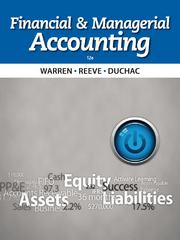Accounting lab
Multiple Choice (2 points each) The 2020 inventory data for Wood Corporation's is presented below. Assume that Wood uses periodic inventory tracking Beginning Inventory (purchased in 2019) 200 units @ $32 per unit Purchases: Purchase 1 on 2/4/20 200 units @ $34 per unit Purchase 2 on 6/8/20 400 units @ $36 per unit Sales: Sale 1 on 3/28/20 300 units @ $70 per unit Sale 2 on 10/15/20 340 units @ $70 per unit When Wood examines the actual units in ending inventory, they see that 20 of the units are from beginning inventory, 60 units are from the 2/4/20 purchase, and 80 units are from the 6/8/20 purchase 1. What is Inventory on the 12/31/20 Balance Sheet if Wood uses FIFO? a. $22,480 b. $21,840 C. $5,760 d. $5,120 2. What is Cost of Goods Sold on the 2020 Income Statement if Wood uses LIFO? a. $22,48 $21,840 c. $5,760 $5,120 . What is Inventory on the 12/31/20 Balance Sheet if Wood uses Specific Identification? a. $22,040 b. $21,840 c. $5,560 d $5,120 What is Gross Profit on the 2020 Income Statement if Wood uses Weighted Average Cost? a. $22,08 b. $22,720 c. $22,760 d. $22,9605. In the period of declining prices, which of the following inventory methods generally results in the lowest income statement amount of Cost of goods sold? a. FIFO b. LIFO c. Weighted Average Cost d. Specific Identification 6. Bright Eyes uses a periodic inventory system. When employees count the inventory on December 31, 2019, they accidentally count one box of eyeglasses twice, resulting in 2019 ending inventory being overstated by $10,000. The employees count the December 31, 2020 inventory correctly. Which of the following statements is true related to Bright Eyes' 2020 and 2019 financial statements? a. 2019 Cost of Goods Sold will be overstated by $10,000. . 2019 Beginning Inventory will be understated by $10,000. C. 2020 Cost of Goods Sold will be overstated by $10,000 d. 2020 Beginning Inventory will be understated by $10,000. e. None of the above are true. Use PVH Corp.'s most recent financial statements to answer the following three questions. 7. Which inventory cost flow assumption does PVH use to value inventories in North America? a. FIFO b. LIFO c. Weighted Average Cost d. Specific Identification 8. What is the most likely reason that PVH chose this inventory cost flow assumption (given rising price trend)? a. To report higher Net Income on its Income Statement. b. To report higher Total Assets on its Balance Sheet. c. To pay less taxes. d. Both a and b are true. 9. Which of the following statements is TRUE regarding PVH's Income Statement? a. Fiscal year 2019 COGS > Fiscal year 2018 COGS b. Fiscal year 2018 Gross Profit Fiscal year 2018 Gross Profit. d. Fiscal year 2019 Operating Income > Fiscal year 2018 Operating Income. e. Both a and c are true.Problem (32 points) Willow Corporation uses a PERIODIC inventory system. Willow had the following inventory purchases and sales during 2020: 2020 Beginning Inventory (bought in 2019) 70 units @ $44 per unit Purchases: Purchase 1 on 1/20/20 130 units @ $48 per unit Purchase 2 on 6/24/20 300 units @ $52 per unit Sales: Sale 1 on 3/12/20 180 units @ $100 per unit Sale 2 on 10/15/20 260 units @ $100 per unit Of the units sold on 3/12/20, 50 came from beginning inventory and 130 were from the 1/20/20 purchase. All units from the 6/24/20 purchase. sold on 10/15/20 were from the 6 Show how Willow's Balance Sheet and Income Statement would look under each of the inventory cost flow assumptions. Compute Ending Inventory, Sales, COGS, and Gross Profit under Specific Identification, Weighted Average Cost, FIFO and LIFO. Fill in your answers on the table below. SHOW YOUR WORK. Round per unit cost to the nearest cent Specific Weighted Identification Average FIFO LIFO 12/31/20 Balance Sheet Inventory 2020 Income Statement Sales Cost of Goods Sold Gross ProfitPVH Corp. Financial Statements (partial) PVH Consolidated Income Statements In millions of dollars Year ended Year ended Year ended Feb. 2, 2020 Feb. 3, 2019 Feb. 4, 2018 Sales $ 9,909 $ 9,657 3 8,915 Cost of goods sold 4,521 4,349 4,020 Selling, general, and administrative expenses 4,715 1.433 4,245 PVH Consolidated Balance Sheets In millions of dollars As of ASSETS Feb. 2, 2020 As of Feb. 3, 2019 Cash and cash equivalents $ 503 $ 452 Accounts receivable, net 741 778 Inventories 1,616 1,732 Prepaid expenses and other current assets 534 277 Total current assets $ 3,394 $ 3,239 Notes to Consolidated Financial Statements (partial) Footnote 1. Summary Of Significant Accounting Policies 1.1. Description of Business PVH Corp. constitutes a global apparel company with a brand portfolio consisting of nationally and internationally recognized trademarks, including TOMMY HILFIGER, CALVIN KLEIN, Van Heusen, IZOD, ARROW, Warner's, Olga, True&Co and Geoffrey Beene, which are owned, as well as various other owned, licensed and, to a lesser extent, private label brands. The Company designs and markets branded dress shirts, neckwear, sportswear (casual apparel), jeanswear, performance apparel, intimate apparel, underwear, swimwear, swim products, handbags, accessories, footwear and other related products and licenses its owned brands globally over a broad array of product categories and for use in numerous discrete jurisdictions 1.4. Fiscal Year The Company uses a 52-53 week fiscal year ending on the Sunday closest to February 1. Results for fiscal years 2019, 2018 and 2017 represent the 52 weeks ended February 2, 2020, 52 weeks ended February 3, 2019 and 53 weeks ended February 4, 2018, respectively. 1.9. Inventories Inventories are comprised principally of finished goods and are stated at the lower of cost or net realizable value. Cost for substantially all wholesale inventories in North America and certain wholesale and retail inventories in Asia is determined using the first-in, first-out method. Cost for all other inventories is determined using the weighted average cost method










